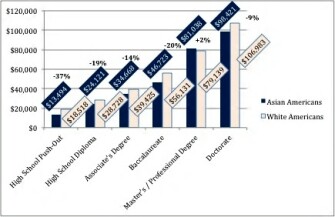UPDATED
At nearly every level of educational attainment, whites earn more money than Asian-Americans.
The one exception is that Asian-Americans whose highest level of education is a graduate or professional degree (other than a doctorate) make about 2 percent more money than whites with the same level of education, according to a research study published earlier this year in Teachers College Record, a peer-reviewed journal. At every other level of educational attainment (less than high school, high school, an associate degree, a bachelor’s degree or a doctorate), whites earn 9 percent to 37 percent more money than Asian-Americans.

Earning power for white and Asian-Americans by educational attainment, 2010 (Source, U.S. Census Bureau, Asian-American Education and Income Attainment in the Era of Post-Racial America, Alejandro Covarrubias & Daniel D. Liou, Teachers College Record, 2014)
The study concludes that the difference may be even more dramatic than it appears since Asian-Americans are more likely than whites to live on the West Coast or in Northeastern cities, where the cost of living is higher than it is elsewhere in the country.
The study was conducted by Alejandro Covarrubias, a community scholar at the Institute of Service-Learning, Power, & Intersectional Research, and Daniel Liou, an assistant professor of education at Arizona State University. It draws upon the March Supplement of the Census 2010 Current Population Survey of 77,000 U.S. households. In doing so, it begins to address the shortage of nuanced research on Asian-Americans,who are the nation’s most rapidly expanding minority group, growing by 43 percent between 2000 and 2010, to 18.5 million people or 6 percent of the total population.
Too often, Covarrubias and Liou write, Asian-Americans are simplistically and inaccurately portrayed as “model minorities” whose success represents the “declining significance of race and racism.” For instance, Liou describes in the paper how one classmate in his master’s program assumed he had grown up outside the United States while another began quizzing him about how many Advanced Placement classes he had taken in high school. Only later did everyone learn that Liou was a first-generation college graduate who had attended American schools, albeit in much less privileged circumstances than many of his peers.
Covarrubias and Liou demonstrate that the real picture is nuanced like Liou’s own personal experience by breaking down the data in their sample, which spanned 1986-2001, by gender, citizenship status, and socioeconomic status. Among their findings:
- Although Asian-Americans are often portrayed as uniformly affluent, nearly 40 percent lived in families in which the income was less than $50,000 per year. An additional 32 percent of Asian-American families earned $50,000 to $99,000 annually. “As might be expected, those with the lowest income are least likely to earn a degree compared with those of the highest income at all levels of the educational pipeline,” Covarrubias and Liou write.
- Foreign-born, naturalized Asian-American males in the sample were 50 percent more likely to leave college before earning a degree than were U.S.-born Asian-American males.
- For the study sample, 20 percent of the foreign-born Asians sample who were educated in the United States were undocumented. Most (56 percent) were female.
The authors conclude by suggesting that, even though Asian-American educational attainment is, on average, strong, inequities remain and should not be ignored by research or policy.
“Our study was conducted at a time where the majority of the Supreme Court still insists upon a colorblind approach to law and social policy,” said Liou. “Our study clearly shows the danger of continuing this path of denial that presumes that race does not play a role anymore in our society. By living in denial, race will continue to matter as long we refuse to face up to the challenges of an increasingly diverse but highly stratified and segregated educational system. The history and experiences of Asian-Americans is another example, among many, that race matters.”
Although the full version of the article is only available to subscribers to Teachers College Record , a briefer version of the study results is freely available on the website of Asian-American Legal Defense and Education Fund.
Daniel Liou discusses his co-authored research study, which appeared earlier this year in Teachers College Record.
